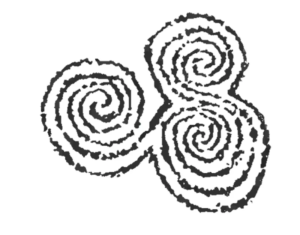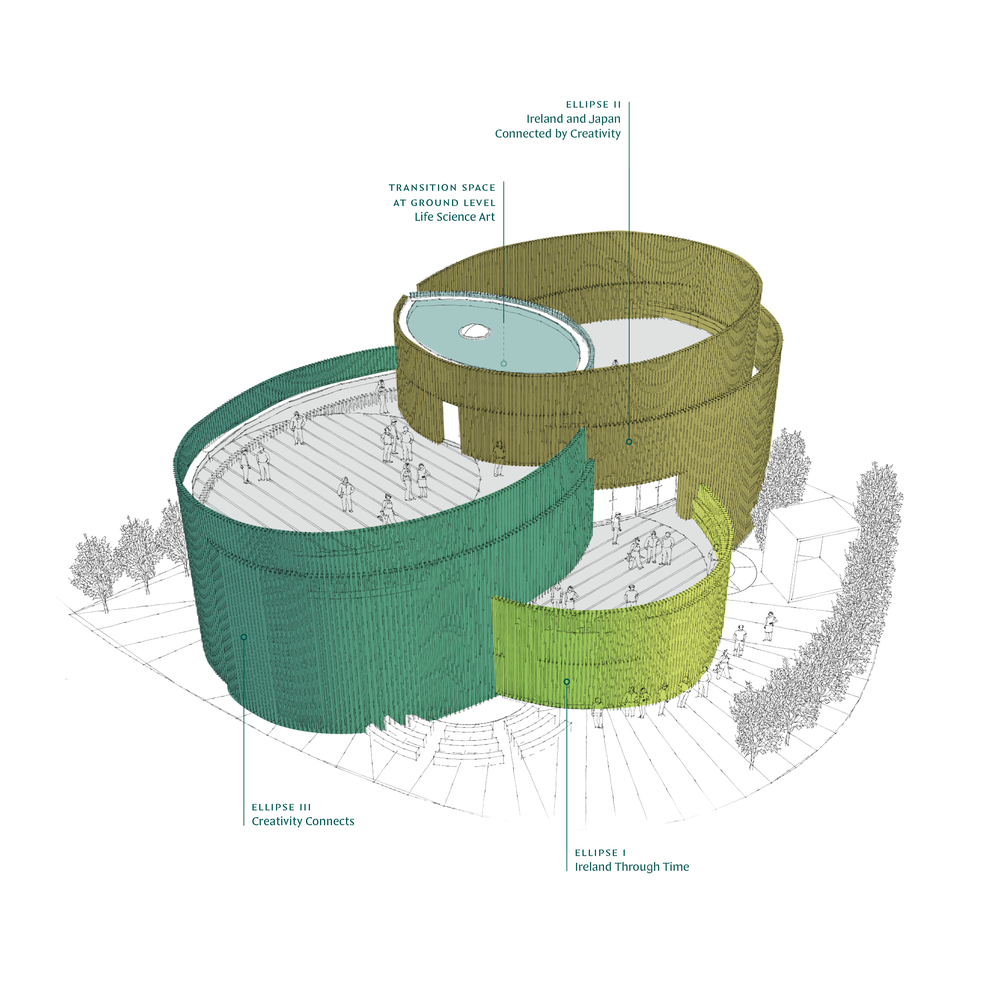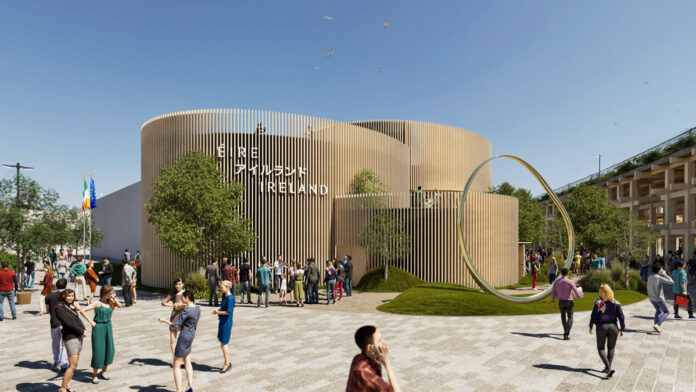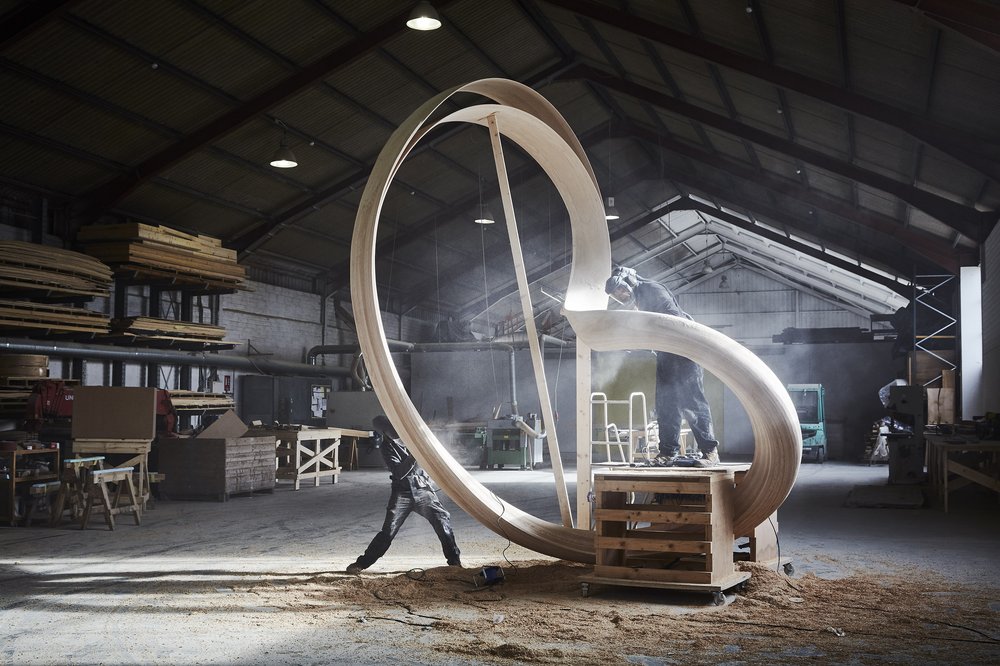The purpose of the Irish pavilion is to provide an environment in which our visitors can engage on a personal level with our exhibitions, displays, performances and pavilion team.
A harmonious relationship between built and natural environment was key to the design of the Ireland Pavilion. Located beside the main entrance to Expo and adjacent to the Grand Roof, a circular elevated and landscaped wooden walkway forming a ring around the site, it acts as a ‘gateway’ for visitors to the entire Expo site.
An abstracted triskele
Government of Ireland architects from the Office of Public Works (OPW) designed the building, made up of three elliptical areas and a central interlocking space, to represent an abstracted triskele in three dimensions.
The triskele is an ancient motif which has appeared in Irish art and craft since Neolithic times. The symbol was used by the ancient Celts in Ireland as a way to mark sacred sites, such as Newgrange passage tomb in the UNESCO Boyne Valley heritage site. The triskele plays an important role in Irish history, and continues to be a popular and recognisable symbol in Ireland today.
 The pavilion is clad in Irish-grown Douglas fir timber, provided by Coillte. The wood of the cladding echoes the wood of the nearby Grand Roof, evoking a connection between Irish and Japanese craft.
The pavilion is clad in Irish-grown Douglas fir timber, provided by Coillte. The wood of the cladding echoes the wood of the nearby Grand Roof, evoking a connection between Irish and Japanese craft.
The Ireland pavilion design will bring visitors on a journey through the three ellipses of the pavilion which are being curated by the National Museum of Ireland.
Creativity Connects People
Ireland’s theme for Expo is ‘Creativity Connects People,’ a concept which is brought to life in our pavilion.
Through this theme, we will show how imagination is central to all human progress and to empowering young and old to live full and productive lives.
Magnus Rinn
Outside the pavilion, a monumental sculpture conceptualised by Joseph Walsh and made in collaboration with his team will act as a tangible expression of our theme, combining beauty of form with natural materials and creative making.
The sculpture, Magnus Rinn, will sit in a specially made landscape designed by Hiroyuki Tsujii, the custodian of the Karasaki Pine Tree, in collaboration with Joseph Walsh Studio.
The spaces
The first ellipse
The first ellipse Ireland: Through Time contextualises Ireland for the visitor, geographically and as a place of creativity. Inside this space, the visitor will become familiar with Ireland in the world, and explore making and craft in Ireland from prehistory to the present-day.
A visual and sensory experience of craft from metal, wood, basket and stone work, and an evolving musical language derived from nature and extending to life-sciences, design-making and contemporary expressions of Irish music and arts.
This time-based representation of Ireland will be set against the landscape and the sounds of nature, with specially created film and audio content that echoes the external setting of the Magnus Rinn sculpture. The second ellipse
The second ellipse
The second ellipse Ireland and Japan, Connected by Creativity shows the geographical and cultural connections between Ireland and Japan. Visitors will explore the contemporary connections between Ireland and Japan, especially in life sciences, and various craft forms.
Connected by Creativity shows values, cultures and creative processes that are shared by the peoples of Japan and Ireland. It will also tell stories about Irish innovation, for instance in the life-sciences field and Ireland’s contribution to developing the UN Sustainable Development Goals.
In a hands-on exploration, visitors can touch and feel a variety of materials and objects from woodwork to ceramics to textiles, and watch videos illustrating the creative making processes.
Connected by Creativity is being developed alongside Rinn at Ireland House Tokyo, with which it will share elements and ideas.
Transition space
Between the second and third ellipses, the visitor will pass through a transition space, featuring a suspended sculptural element inspired by life sciences – exploring the interactions between art and science.
The third ellipse
The third ellipse, Creativity Connects, shows how creative collaboration generates understanding between peoples. Creativity Connects invites our pavilion visitors to connect through a shared experience in which the lightest of gestures can create new and different sounds and images – a spontaneous moment of co-creation, derived from millennia of tradition and craft, informed by modern technology.
Creativity Connects will be developed by a creative team overseen by the National Museum of Ireland in collaboration with the National Concert Hall, musician and composer Caoimhín Ó Raghallaigh and filmmaker Marianne Keating, alongside theatre and other specialist designers.






